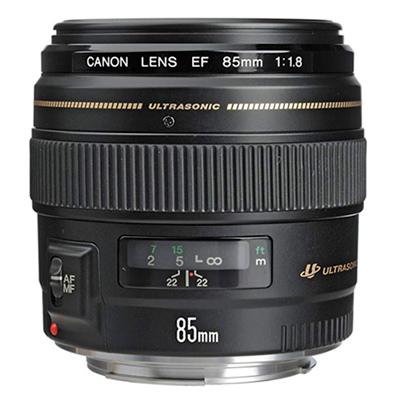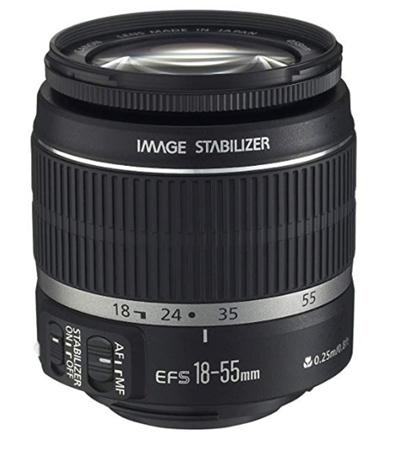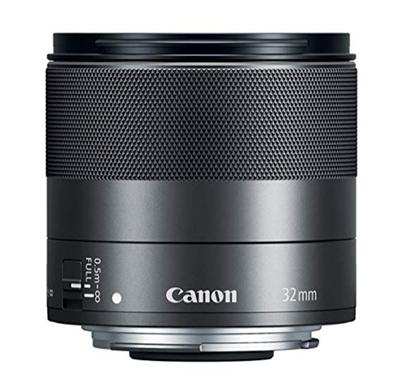Are you using a Canon lens or looking for a new Canon lens? If yes, then you would have come across EF vs EF-S vs EF-M vs RF lens mounts. If you are a newbie in photography, then it might confuse a bit. So, I will try to explain all these four Canon lenses in detail in this article. It will help you to select the right lens for your Canon camera.
First, let us have a clear understanding of what EF, EF-S, EF-M, and RF mean when it comes to Canon camera and lenses.
What is an EF Lens?

EF lenses are Canon lenses for DSLR cameras which are compatible for both Full-frame and APS-C Canon camera bodies.
EF stands for Electro Focus, which indicates that there is electronics inside the lens, which is used for focusing the lens. It came into existence in 1987. It is the successor of Canon’s older FD lenses.
Canon EF lenses come with a red dot in the exterior part, the end where the lens gets connected to the camera. It is also the mounting alignment point for the body and the lens.
Canon EF Lens Examples: Canon EF 70-200mm f/4 L IS II USM Lens, Canon EF 500mm f/4 L IS II USM lens, Canon EF 50mm f/1.8 STM lens, etc.
What is an EF-S Lens?

EF-S lens is a derivative of the EF lens, where the letter” S” stands for Smaller Image Circle.
It is for Canon APS-C DSLR camera bodies. It came into existence in 2003.
Canon EF-S Lens comes with a white dot on the lens body. It acts as the mounting guide.
Canon EF-S Lens Examples: Canon EF-S 24mm f/2.8 STM Lens, Canon EF-S 10-18mm f/4.5-5.6, IS STM lens, Canon EF-S 55-250mm f/4-5.6 IS STM lens, etc.
What is an EF-M Lens?

The EF-M lenses are for Canon APS-C Mirrorless cameras. They were introduced in 2012 with the launch of Canon interchangeable mirrorless cameras. 1.6x Crop factor comes into picture when you used EF-M lenses. It also has a white dot as the mounting guide, similar to the EF-S lenses.
Canon EF-M Lens Examples: Canon EF-M 11-22mm f/4-5.6 IS STM lens, Canon EF-M 22mm f/2 STM lens, Canon EF-M 18-150mm f/3.5-6.3 IS STM lens, etc.
What is an RF Lens?

RF lenses will work with Canon Full-frame camera bodies. Canon announced the RF mount in September 2018. It works with both Canon EOS R and EOS RP full-frame mirrorless camera bodies. It has a small red line as the mounting guide locator.
Canon RF Lens Examples: Canon RF 24-105mm f/4 L IS USM lens, Canon 50mm f/1.2L USM lens, Canon 70-200mm f/4-6.3 IS USM lens.
Canon EF Vs EF-S Vs EF-M Vs RF Lenses
If we compare all the four lens mounts from Canon, there is one thing which is common when it comes to EF vs EF-S vs EF-M vs RF lenses. Do you know what it is? They are all lenses designed for Canon Interchangeable lens cameras.
So, your question would be, Why Canon uses four different lens mounts for their Mirrorless and DSLR cameras?
It is due to the difference in a parameter called the “Flange Focal Distance”. In simple terms, it is the distance between the mounting metal ring on the camera body and the camera sensor. This flange focal distance varies for all the four types of Canon interchangeable lens cameras. So, the lens mount is also different.
Flange focal distance for Different Canon Interchangeable lens cameras are below:
Canon EF Mount: 44mm
For Canon EF-S Mount: 26mm
Canon EF-M Mount: 18mm
For Canon RF Mount: 20mm
Canon EF Vs EF-S Lenses
You can use Canon EF lenses on both Canon Full-frame and APS-C DSLR camera bodies.
But, you can use Canon EF-S lenses only with Canon APS-C DSLR cameras. It is one of the major differentiating factors.
The image circle projected by an EF-S lens is smaller than that of an EF lens. It is due to the Flange focal distance difference.
So, as a result, Canon APS-C DSLR camera bodies will have more choice of lenses.
Whichever type of lens you use with an APS-C Canon camera, you need to take the Crop factor also into account. 1.6x is the crop factor for Canon APS-C DSLR cameras. So, the sufficient focal length increases by a factor of 1.6.
Thus, the effective focal length of a Canon EF 300mm f/4 L IS USM lens mounted on a Canon 7D Mark II body is 480mm. Therefore, you get the extra reach, which is useful for certain types of photography like Birds, Wildlife and Sports.
Canon EF-M Vs RF Lenses
Canon EF-M lenses are designed for APS-C Mirrorless camera bodies. RF lenses are for full-frame Canon mirrorless cameras.
Is it Possible to use Canon EF and EF-S lenses on Canon Mirrorless cameras?

Yes, you can use EF and EF-S lenses on Canon mirrorless cameras (Canon EOS R and EOS M cameras), but not directly. You need to buy a lens adapter, which makes these lenses compatible with the mirrorless cameras.
Mount Adapter EF-EOS M will help you to mount EF and EF-S lenses on a Canon EOS M cameras.
Currently, Mount Adapter EF-EOS R will make your EF, and EF-S lenses work with Canon EOS R cameras. This adapter cost $99.99.
There are two more EF-EOS R Adapters from Canon which comes with additional features. One is the Control Ring Mount Adapter which comes with a lens control ring. The third one is the Drop-in Filter Mount adapter which has the option to add drop-in filters like the CPL or ND filter to the camera.
You may also find such adapters from third-party manufacturers.
So, if you already own good EF and EF-S lens from Canon, then the EF-EOS R adapter would be a good choice. It will make your current DSLR lenses compatible with the mirrorless camera bodies.
Can I use EF-M & RF lenses on Canon DSLR camera bodies?
As of now, you can’t use EF-M lenses on Canon DSLR bodies. It is because no manufacturer has come up with an adapter which makes these lenses compatible with an APS-C mirrorless camera.
I don’t think anyone will be looking to buy an EF-M lens to use it with a Canon DSLR camera.
Conclusion
So, next time, when you are buying a Canon camera lens, make sure to buy the right type of mount, which is compatible with your type of interchangeable lens camera.

